Top News
July 29, 2016 Ryukyu Shimpo
By Wu Li Jun
The main entrance to Okinawa, Naha Airport, recorded 18.54 million visitors over the past year. The number increased by 5.8 percent on the previous year, breaking a new record. The airport has broken its visitation record for four consecutive years. The number of users of the international airport has quadrupled over the past four years, with 2.5 million people using the airport in the past year. The number of people coming to Okinawa on domestic flights reached 16.04 million people, an increase of 0.9 percent. Factors such as the opening up of new routes as well as a drastic increase in multiple visas have contributed to the rise in the number of foreign visitors to Okinawa.
In 2008, flights between Okinawa and other countries previously only included three routes (Taipei, Seoul, and Shanghai), with a total of 19 flights per week. As of the end of 2012, there were five routes with the addition of Hong Kong, and Taichung, and 49 flights per week. In 2014, the number of routes increased to nine routes and there were 121 weekly flights. In the four years between 2012 and 2015, 104 new flights were launched, pushing up the number of passengers at the Naha Airport.
The Okinawa multiple visa issued by the Ministry of Foreign Affairs of Japan for Chinese individual tourists was 60,298, 3.3 times more than in 2014. This is also the highest number ever. In 2011, when the visa was introduced, the number of visas issued was 8,964. This figure was 6.7 times increase in four years previously. The weakening of the yen as well as newly established routes between Okinawa and China also contributed to the increasing number of Chinese visitors to the island.
At the same time, an access way between the international airport and the domestic terminal building was built in order to improve convenience for customers. The access way has been open since July 15. The 355-meter access way connects the domestic flights building to the second floor of the international flights building, and the newly built third parking structure.
Previously the airport did not have covered access between the domestic building and international building, which a number of customers made complaints about.
(English translation by T&CT and Sayaka Sakuma)
Go to Japanese
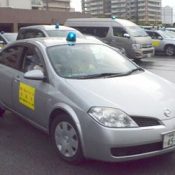
July 27, 2016 Ryukyu Shimpo
On July 26, news covered that the Ministry of Defense (MOD) dispatched 60 officers to Okinawa to help as crime prevention patrols in response to the incident of a woman assaulted and killed by a U.S. base employee, but that the officers are instead on-duty as guards to the helipad construction site in Higashi Village, Takae. These patrol officers, extolled as an incident prevention policy, are actually engaging in work to suppress Okinawan citizens’ protest activities. This calls the lawfulness of dispatching these personnel into question.
A contact person at the MOD said that the personnel were intended to both patrol and guard against protest activity, explaining that it is better for patrolling officers to be familiar with local geography. The contact person asserted that it is also essential that the personnel deal with helipad construction.
The MOD and government started crime-prevention patrols in June within Okinawa in response to the U.S. base employee incident, and anticipated the shortage of Okinawa Defense Bureau (ODB) personnel to assist with helipad construction planned for resumption in July. As such, the central MOD and the local ODB dispatched approximately 60 personnel within Okinawa on and after July 13.
(English translation by T&CT and Erin Jones)
Go to Japanese
August 2, 2016 Ryukyu Shimpo
According to the Okinawa Meteorological Observatory, average temperatures in the Okinawa region for July were higher than usual by 0.9 degree Celsius, equal to the highest temperature recorded since statistics started in 1946. The monthly average sea surface temperature in Southern Okinawa including Sakishima islands was 30.1 degree, higher than usual by 0.8, and the highest since 1982 when the analytical value was calculated for the first time.
The average Okinawa temperature anomalies were derived from averaged temperature anomalies in five areas including Naha, Kumejima, Miyakojima, Ishigaki Island, and Yonaguni Island. While the average temperature in Kumejima was higher than usual by 1.1 degree, the figures in four other areas were higher by 0.9.
Out of 26 observation points in Okinawa, monthly average temperatures in 9 areas including Izena, Nago, and Kumejima were the highest they have been for a year.
Sea surface temperatures have been high since the end of the rainy season, except for in the middle of July when Typhoon Nepartak hit the prefecture.
The meteorological observatory stated that while the equatorial sea surface temperature was higher than usual, areas around Indonesia have likely had cumulonimbus clouds, which may have brought damp air into areas around the Philippines. A pacific anticyclone moved westward and then covered the Okinawa region, which increased average temperatures there.
The observatory predicted that average temperatures in the region would continue to be high into August.
(English translation T&CT)
Go to Japanese
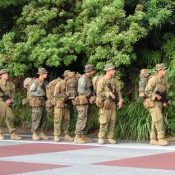
July 27, 2016 Ryukyu Shimpo
In Takae, Higashi around 7:15 a.m., about 10 armed U.S. military personnel made their way north on Okinawa Prefectural road 70. According to local eyewitnesses, the solders traveled north from the intersection at Arakawa Dam, carrying guns. A woman who saw the soldiers, said, “They looked tired. I guess it was after training.” She added, “What authority did they have to carry guns walking on the prefectural road as if they owned it?”
(English translation T&CT)
Go to Japanese

July 22, 2016 Ryukyu Shimpo
A Swedish restaurant named “SMAKAKA (Småkaka)” opened in Kadekaru, Kume-jima this April, providing a space for the community to socialize. The owner is 53-year old Anna Edberg who moved to the island from Sweden. Local women provide assistance at the restaurant to support Edberg, who is not very fluent in Japanese. Customers not only enjoy the meals but also engaging in conversations with her in English. The restaurant is packed with visitors. Edberg is from Gothenburg in Sweden, where she has worked as a chef and as a manager overseeing hundreds of employees. Her son, who was studying at a university in Japan, married a Japanese woman in 2014. When she visited Zamami village with them, she was fascinated by the ocean around Okinawa. Edberg came up with the idea to open her own restaurant on a neighboring island of Okinawa and purchased an old house in Kume-jima. She visited the island three times from Sweden before relocating there, and remodeled a part of the house into a North-European styled restaurant.
The restaurant is well known for its daily lunch menu. Edberg uses many vegetables and bakes her own bread and cookies. She also uses herbs and vegetables grown in her own garden. She said that although her dishes take a long time to prepare, they are considered good for health in Sweden.
The restaurant has taken on four local women who lend a hand with customer service as volunteers. Forty-eight-year old Tami Yohena, who started assisting the restaurant because she wanted to learn English, said, “Helping the restaurant opens up my worldview as well. I hope Anna-san will enjoy life on the island as much as possible.”
Edberg said that the people of Kumejima are curious and very friendly. She smiled and went on to say that she likes adventures and will continue the restaurant for three years, and then considers future plans after that. She also said that she hopes the restaurant can be like a community space where people gather.
(English translation by T&CT and Sayaka Sakuma)
Go to Japanese
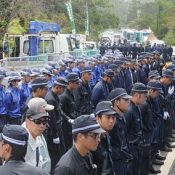
July 25, 2016 Ryukyu Shimpo
By Ayako Sakaguchi
As sit-in protests continue daily in opposition to the construction of new helipads in the U.S. military’s Northern Training Area, people from outside the village can be heard making comments such as, “Almost none of the locals are actually participating in the protests, are they?”
“There’s not a single person here in favor [of the helipad construction].” Takae resident Naohide Urasaki, 68, speaks in an emphatic tone in response to such criticism. Takae residents released resolutions opposing the helipad relocation at assembly meetings in 1999 and 2006. Nevertheless, Higashi Village Mayor Seikyu Iju accepted the relocation, and two of the six planned helipads have already been built. Urasaki himself almost never participates in the sit-ins protests. “I want to join the movement, but with my fields to tend to, I can’t spend the whole day there,” he explains.
The ward of Takae has only 140 residents, most of whom make a living as farmers. If a farmer neglects his fields for even a day, it will negatively affect his crops. Many people are opposed to the helipad construction but are unable to protest actively because their livelihoods are at stake.
Farmer Yoshikatsu Takaesu, 73, says, as though trying to convince himself, “The Osprey are noisy, and I oppose the helipads. But I have to prioritize being able to eat. How can I manage to eat if I spend my days at the sit-in protests?”
Ward chief Kumiko Nakamine, 66, says that she thinks of the residents of her ward as family. Her face shows fatigue as a result of endless questions from groups of reporters. “The policing is intense, and traffic has increased. I worry that it will negatively impact the lives of the residents here,” she says, expressing her concern.
Takashi Kiyuna, 45, says, “Because it is such a small ward, connections are very important to us. Many people aren’t saying things that they want to say.”
A man in his sixties spoke in a small voice, saying, “Some people find it hard to raise their voices, for instance because their son was able to find a job at the village office.”
Some commentary implies that politics are tearing Takae in two as the government pushes forward with the construction. Urasaki has been told by fellow Higashi villagers, “The situation in Takae is tough, isn’t it?” as though the situation had nothing to do with them. However, Urasaki says, “That’s not how it is. This is a national issue, and as residents of the same village, I want them to think about it. If the [Higashi] village leadership were to come out in opposition, I think everyone would come together and do their best. Takae isn’t being torn in two at all. Everyone is opposed.”
Okinawa Governor Takeshi Onaga has conveyed to the national government his opposition to the relocation of U.S. Marine Corps Air Station Futenma to Henoko, Nago City. The construction at Henoko is currently stopped. In the small ward of Takae, people struggle between a sense that even if they raise their voices, nothing will change, and a desire to see the situation change through a spread of awareness nationwide.
(English translation by T&CT and Sandi Aritza)
Go to Japanese
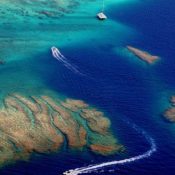
July 26, 2016 Ryukyu Shimpo
On July 25, as part of a project it will embark on with the objective of drawing foreign tourists to Japan’s regional areas, the Ministry of the Environment (MOE) determined a policy to brand Zamami and Tokashiki Villages in the Kerama Islands as a national park, and to promote the maintenance of an environment that is inviting to visitors and the transmission of relevant information internationally. The designation as a national park is part of a “National Park Enjoyment Project” being progressed by the MOE. At a meeting of experts held on July 25, eight locations, including the Kerama Islands, were decided upon as targets for national park designation from a list of 32 locations nationwide.
Now that the designation has been decided, talks will be held between the relevant ministries and agencies and local government bodies, and guide training and town planning will be implemented. On July 20, Okinawa Governor Takeshi Onaga, Zamami Village Mayor Tetsu Miyazato, and Tokashiki Village Mayor Yoshikatsu Matsumoto requested that the islands be designated.
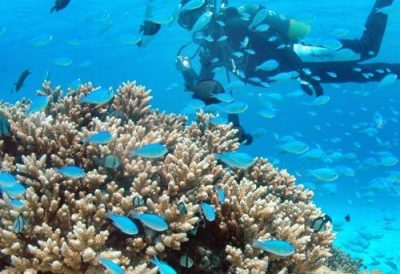
Colorful tropical fish swim in the waters around the Kerama Islands, which are home to spectacular coral reefs. (September 5, 2013, sea around Kerama Village’s Aka Island, depth of approximately five meters)
Regarding the designation, Zamami Mayor Miyazato said, “I have worked to have [the village] designated as a model zone for the project, so I am very glad. I will continue to work to think of ways to help visitors from abroad enjoy their stay here, while also working to conserve the environment.” Tokashiki Mayor Matsumoto said, “I will work to strengthen our capacity to accept tourists, establish and maintain tourist attractions in the village, and establish capacity to accommodate many languages for tourists from abroad. I hope we can form a committee together with representatives from Zamami Village to consider [ways to make it happen].”
Governor Takeshi Onaga commented, “I am very pleased. I want to work together with leaders in Zamami and Tokashiki Villages to move the project forward concretely.”
(English translation by T&CT and Sandi Aritza)
Go to Japanese
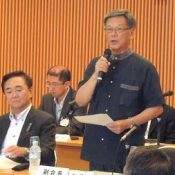
July 26, 2016 Ryukyu Shimpo
On July 25, the Governors’ Association for Military Facilities in Japan (chaired by Governor of Kanagawa Prefecture Yuji Kuroiwa) comprised of fifteen prefectures of Japan where the U.S. has military bases, paid a visit to Minister of Defense Gen Nakatani at the Ministry of Defense. The Governors’ Association made special requests in response to the case of a woman assaulted and killed by a U.S. base employee in Okinawa, calling for preventative measures to incidents and accidents caused by U.S. military personnel, and for the revision of the U.S.-Japan Status of Forces Agreement (SOFA). The Association also submitted a petition on measures relating to U.S. military bases.
According to Governor Kuroiwa, Minister Nakatani said that he first wants “to properly attempt improving implementation of the SOFA,” stopping short of actual revision. In regards to the continuation of U.S. military realignment grants on and after 2017, and the reopening of the liaison conference between the U.S. and Japanese governments and the Governors’ Association for Military Facilities in Japan (which has not taken place since 2008), Nakatani responded that he “wants to consider” these options. On the same day Kuroiwa also made an appeal to the Ministry for Foreign Affairs, and exchanged ideas with the U.S. Embassy in Japan.
On the morning of July 25, both the appeal and petition were adopted at a regular general meeting of the Governors’ Association. Due to the establishment of Kyogamisaki Communications Site in Kyoto Prefecture, Kyoto has been added to the Association as the fifteenth prefecture.
At the meeting vice-chairman of the Governors’ Association Takeshi Onaga spoke about construction of a new base in Henoko accompanying relocation of MCAS Futenma. He warned not to be “drawn in by the fixed idea that Henoko is the only option [for relocation].” In addition, he emphasized his desire for the Government of Japan to consider all methods of relocating MCAS Futenma outside of Okinawa.
Onaga said that the Supplementary Environmental Agreement to the SOFA that was put into practice last year in September might have appeared to be a step forward, but that there are drawbacks as well. One concern is that a survey of buried cultural properties on MCAS Futenma has yet to be achieved.
(English translation by T&CT and Erin Jones)
Go to Japanese
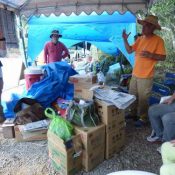
July 25, 2016 Ryukyu Shimpo
The Japanese government has resumed helipad construction in the U.S. military’s Northern Training Area (NTA), which expands from Higashi Village to Kunigami Village. Citizens protesting against the construction have long received supplies such as food from various areas in the main island of Japan. Since the central government removed vehicles and protest tents set up there, shut down the N1 zone gate to the NTA and brought in construction materials on July 22, the protesters have received further supplies. Members of the Association of Residents Against the Helipad said they appreciated the extra supplies and were encouraged by the support from outside of Okinawa.
Beverages, cup noodles, and snacks were packed in cardboard boxes and sent addressed to the sit-in tents and houses of the association members. Some of the supplies have messages such as “Never give up.” The protesters have received dozens of these boxes. The association member Ikuko Isa said, “These supplies will support our struggle. We really appreciate it.”
(English translation T&CT)
Go to Japanese
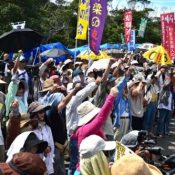
July 22, 2016 Ryukyu Shimpo
The Japanese government is trying to resume helipad construction in the U.S. military’s Northern Training Area (NTA). On July 21, a protest rally against the resumed construction was held in front of the N1 zone gate to the NTA. According to the organizer, about 1,600 people took part in the rally. The government has shut down a part of Prefectural Road 70 and removed vehicles and tents from in front of the gate. The protesters criticized the Abe administration’s hardline stance, saying the administration is autocratic and its latest move is a threat to Okinawan people. They declared they would unite to resist the riot squad sent by the government.
(English translation T&CT)
Go to Japanese
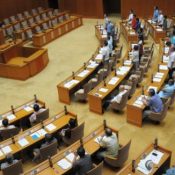
July 21, 2016 Ryukyu Shimpo
At the regular meeting on July 21, ruling parties in the Okinawa Prefectural Assembly passed a position document by majority vote requesting the cancellation of helipad construction in the U.S. military’s Northern Training Area (NTA) in Takae, Higashi Village. The Liberal Democratic Party, which is currently the opposition party in the assembly, voted against the document stating that the cancellation of construction would compromise the plan to return the NTA. Assembly members from Komeito and the Japan Innovation Party took a neutral position and walked out.
In the position document, which asks for the cancellation of helipad construction, assembly members stated that the Prefectural Assembly has previously passed written arguments demanding the withdrawal of the Marine Corps and the recall of Osprey deployment. They went on to say that the construction of Osprey helipads in the Marine Corps’ Training Area is not acceptable. The statement was addressed to the Prime Minister, Foreign Minister, Defense Minister, and Minister in charge of Okinawan Affairs.
The Assembly also unanimously passed a written statement about the incursion of the Chinese Coast Guard ships into Japanese territorial waters around the Senkaku Islands, as well as a document calling for the cancellation of subsidy cuts to the maintenance of school air conditioners.
(English translation by T&CT and Megumi Chibana)
Go to Japanese










 Webcam(Kokusai Street)
Webcam(Kokusai Street)


